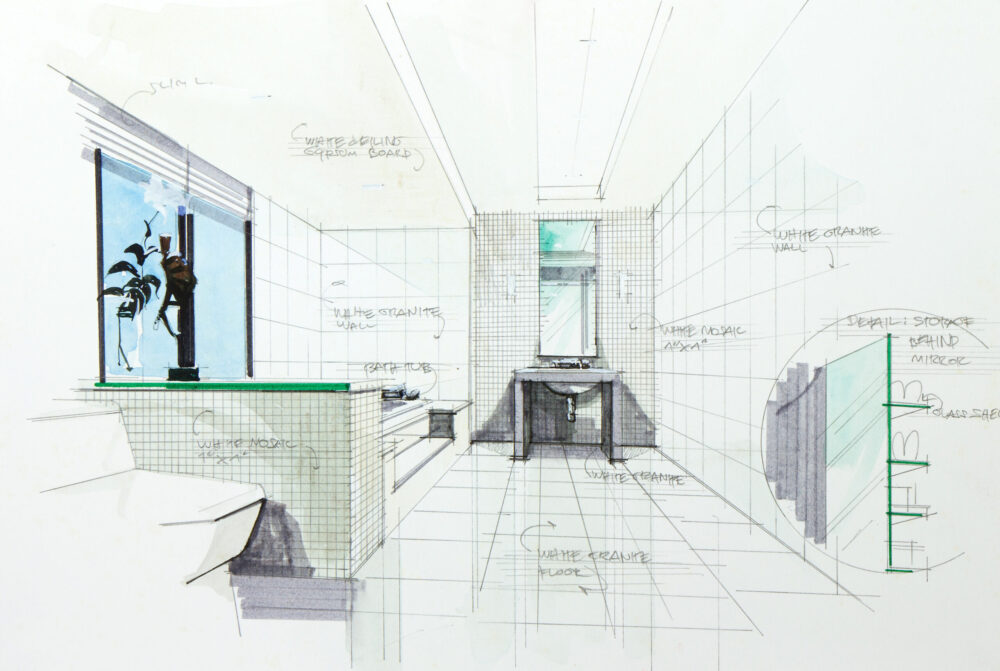As I grow older, I have begun to truly understand how valuable it is to have a zero-barrio home, specifically a bathroom, as we age. Especially for those folks with mobility issues, a zero-barrio bathroom is an ideal and beneficial upgrade to any bathroom design.
But what is a wet room in a bathroom anyway? Wet rooms generally have zero enclosures that separate the shower or tub from the rest of the bathroom. The complete room, including the walls and the flooring, is sealed against water, similar to the surfaces in a typical shower stall, but with the main flooring of the wet room on the same level as the shower floor.
Furthermore, wet rooms have an open concept design, where the shower typically has no tray or door, making it possible to move freely inside. A drain is also installed in the shower area, where the floor has a gentle slope, and water is directed toward it.
Wet rooms are conducive for those with mobility issues who need home assistance to move safely, even in walk-in showers. There is still that little “step” to conquer in a walk-in shower. So which one is better? Let’s find out…
Wet room vs bathroom
The differences are many, but a key indicator is that a wet room (as already discussed) has no step-up into the shower and provides a clear walkthrough. Whereas, a regular bathroom usually has a separate area for bathing, such as a shower or bath, and it is distinct from the rest of the room.
Should the desire to completely renovate the bathroom design be on account of mobility reasons, it is highly suggested to consider a wet room instead. There are several reasons why a wet room is considered safer than a walk-in shower. Here are a few we found to be essential:
- Reduced risk of falls – Probably the most important one of all! With the absence of barriers and steps in a wet room, it eliminates tripping hazards, which reduces the likelihood of accidents and falls, particularly for folks with limited mobility or balance issues.
- Greater accessibility – The level floor allows for easier maneuverability and transfers from mobility devices for those with mobility impairments or who require mobility aids such as wheelchairs or walkers to get around.
- Better visibility – Allows caregivers, home health providers, or assistance devices to have an unobstructed view, ensuring better supervision and assistance without shower enclosures, doors, or cabinetry affecting visibility.
- Way easier to clean – Eliminating the need for shower enclosures or curtains, the seamless design of a wet room reduces potential areas for mold and mildew growth, leaving the entire room to be readily cleaned and maintained, enhancing hygiene as well as reducing slip hazards.
- Waterproofing measures – Constructed with extensive waterproofing measures, wet rooms ensure all surfaces, including walls and flooring, are completely sealed against water. With a comprehensive waterproofing system, it minimizes the risk of water leakage and potential damage to the structural integrity of the bathroom and the overall home.
- Customizable design – More room for flexibility in terms of design and layout because with the absence of fixed shower enclosures, it allows for greater customization that will be able to accommodate specific accessibility needs and preferences.
- Improved hygiene and sanitation – When my mother was declining rapidly with diabetes, mobility and sanitation became a grave concern. With the open layout of a wet room, it promotes better air circulation, reducing the potential growth of bacteria or other contaminants while promoting a cleaner and more hygienic environment overall.
Smart bathroom technology
Remember the old commercial that sang, “Clap on; clap off…the clapper!”? What the “clapper” was to my grandparents, smart home technology is to those of us edging on the cusp of middle age, at least for myself and my fellows. Smart bathroom technology is the perfect accompaniment to a wet room, specifically for the aging population or those with mobility issues.
For example, a motion sensor faucet and toilet automatically detect the presence of a person and initiate the required action, reducing the need for manual interaction, enhancing convenience, and promoting hygiene by minimizing touchpoints.
Moreover, if equipped with voice-activated features to control various aspects of the space without physical contact, they greatly benefit individuals with limited mobility, making it easier for them to customize their bathroom experience according to their preferences and needs.
Some voice-activated features may include:
- Adjusting the temperature of the shower
- Dimming the lights
- Playing music
- Receiving personalized reminders
- Calling for help
Smart bathroom technology lets you turn on the shower while getting coffee or to monitor and change water usage. They are more efficient to use and can be much easier to maintain, especially in a wet room. Smart technology has been proven to save time, money, and natural resources. To date, it is the greener way to go.
Remember to hire professional designers, contractors, and technology crews to ensure your smart bathroom is safe. From planning and design to installation and post-service support, these pros will ensure your new home automation solutions are easy to use.
For instance, with a professional smart home tech installer, expect some of the following:
- Review finished or unfinished space with you and help you navigate the best options for your home automation.
- After installation, they’ll show you the ropes and everything you need to know about using your new home automation tools.
- Once the project is complete, a reputable company will offer some of the industry’s best post-service support plans, a workmanship guarantee, and system warranties.
If they do not offer these solutions, keep doing your research until you find one that does.
Below are some additional options to consider including in a smart bathroom design:
- Smart toilets
- Interactive LED mirrors
- Adjustable privacy glass
- Smart shower
- Chromatherapy lights
- Floor heating system
- Smart scale
- Smart faucets
- Floatation tub
- Smart water assistant
- Water recycler
- Smart fan
What is a wet room bathroom
To reiterate, wet rooms are bathrooms with zero enclosures that separate the shower or tub from the rest of the bathroom. In short, wet rooms provide numerous safety advantages over walk-in showers, making them an ideal choice for individuals with mobility issues or those seeking a safer bathroom design.



tgkh7x
1ilmxz
8nptej